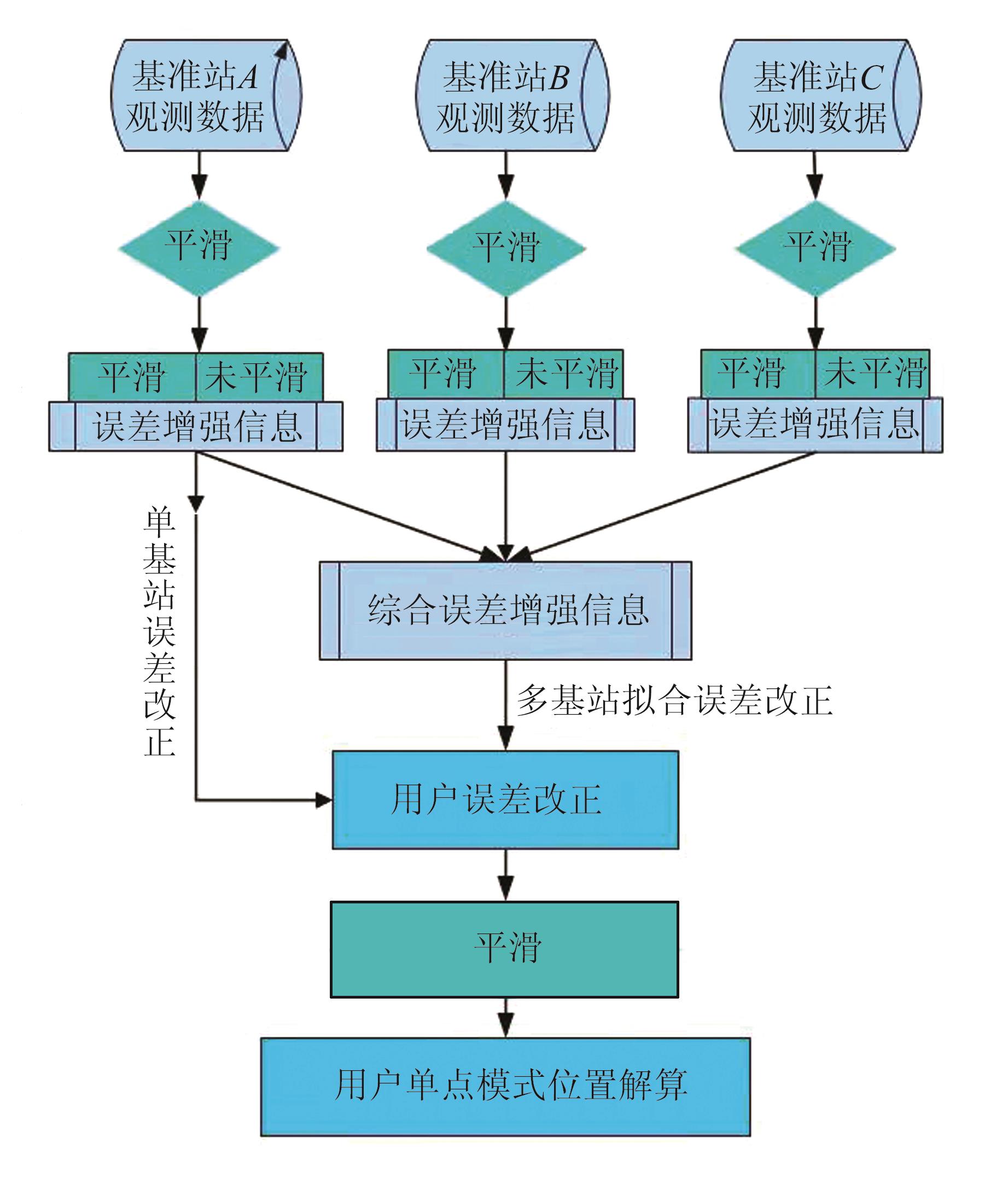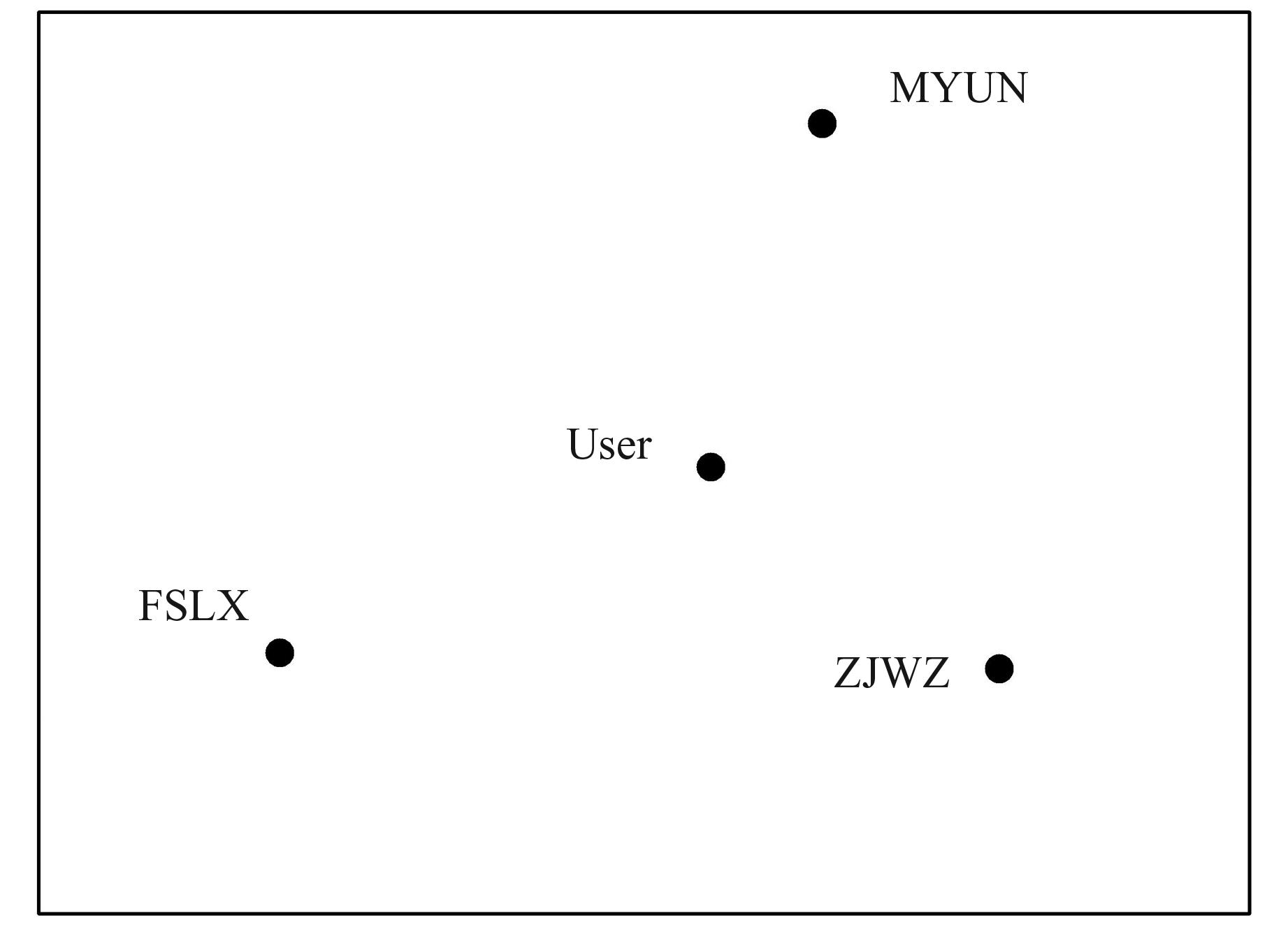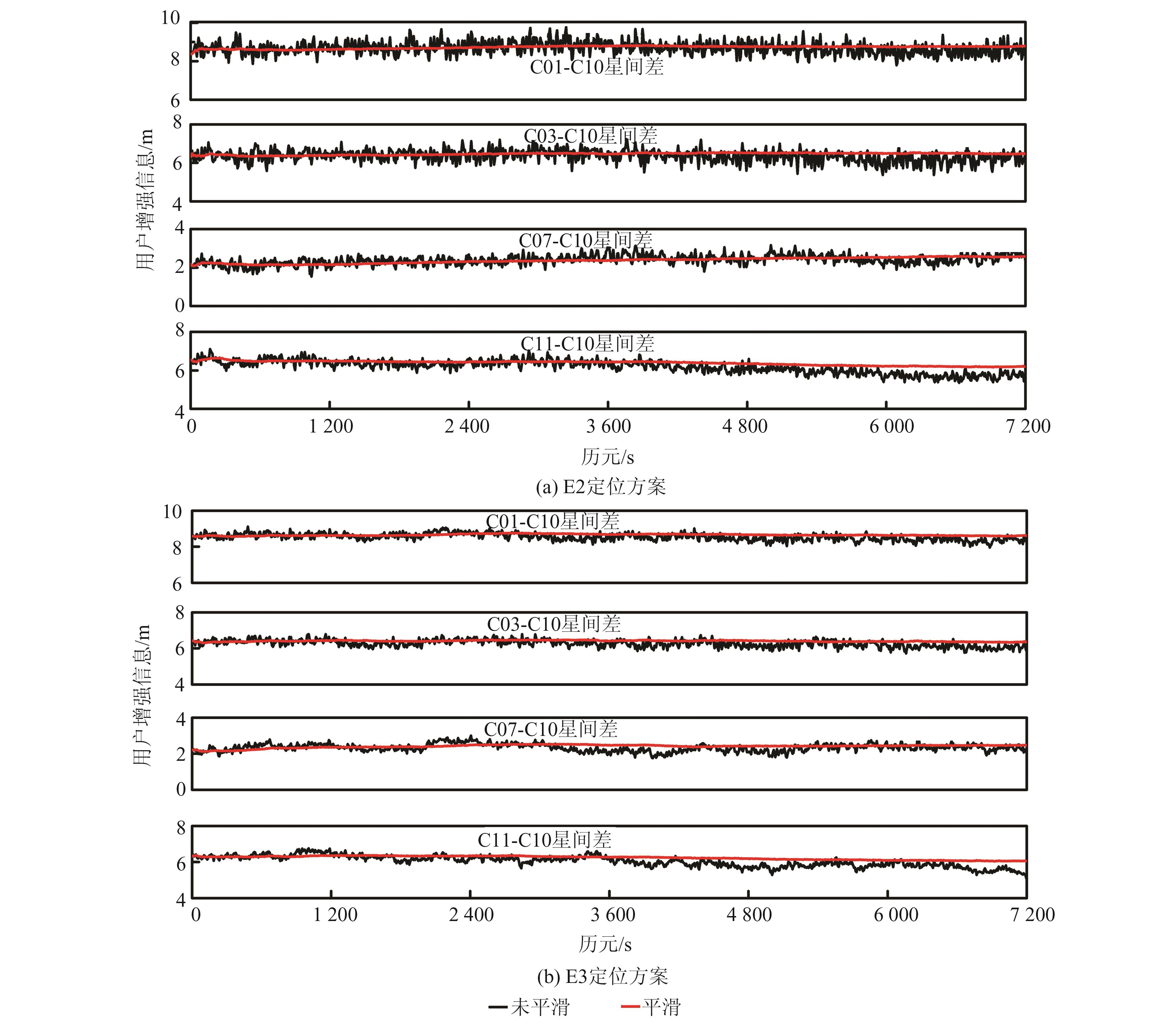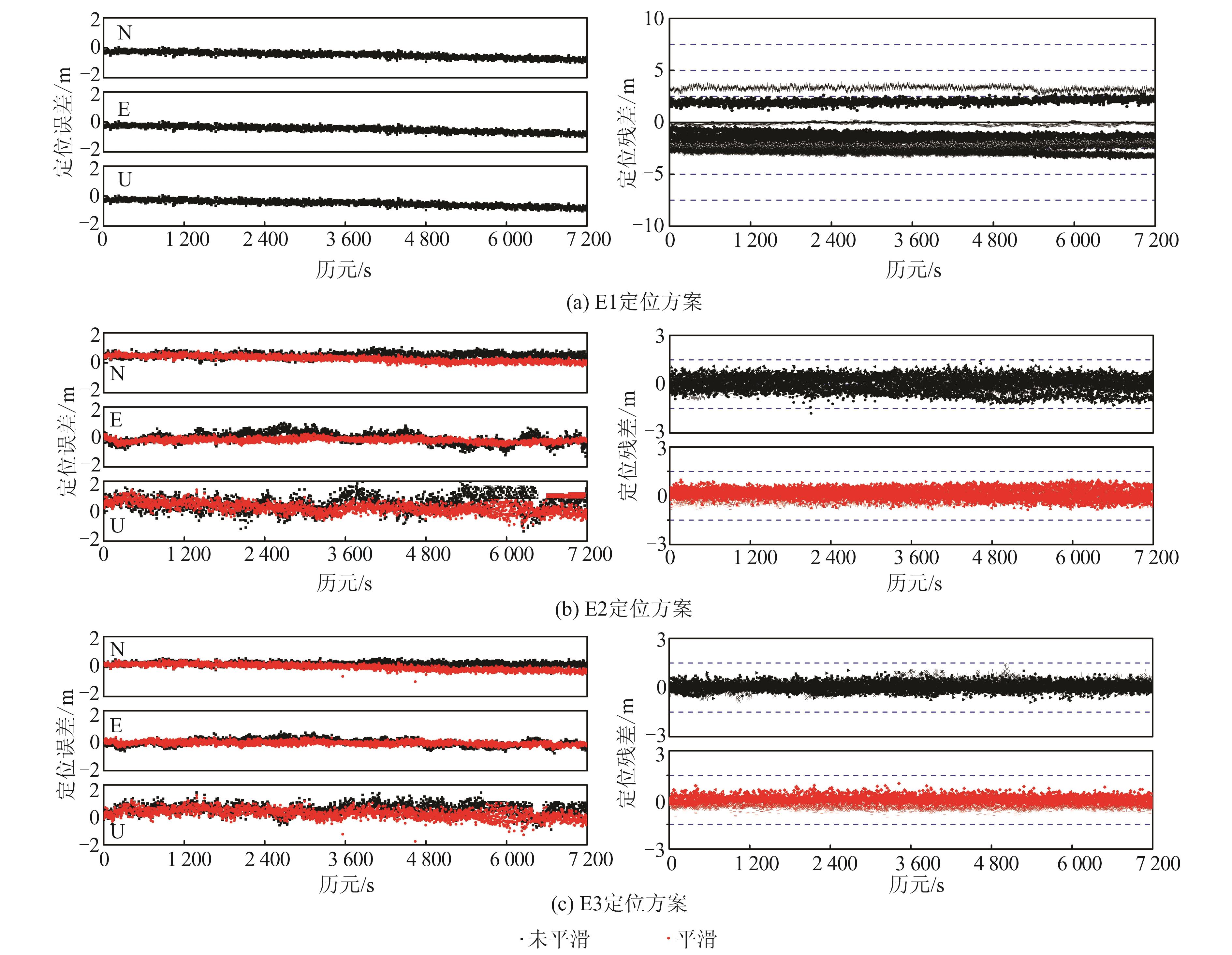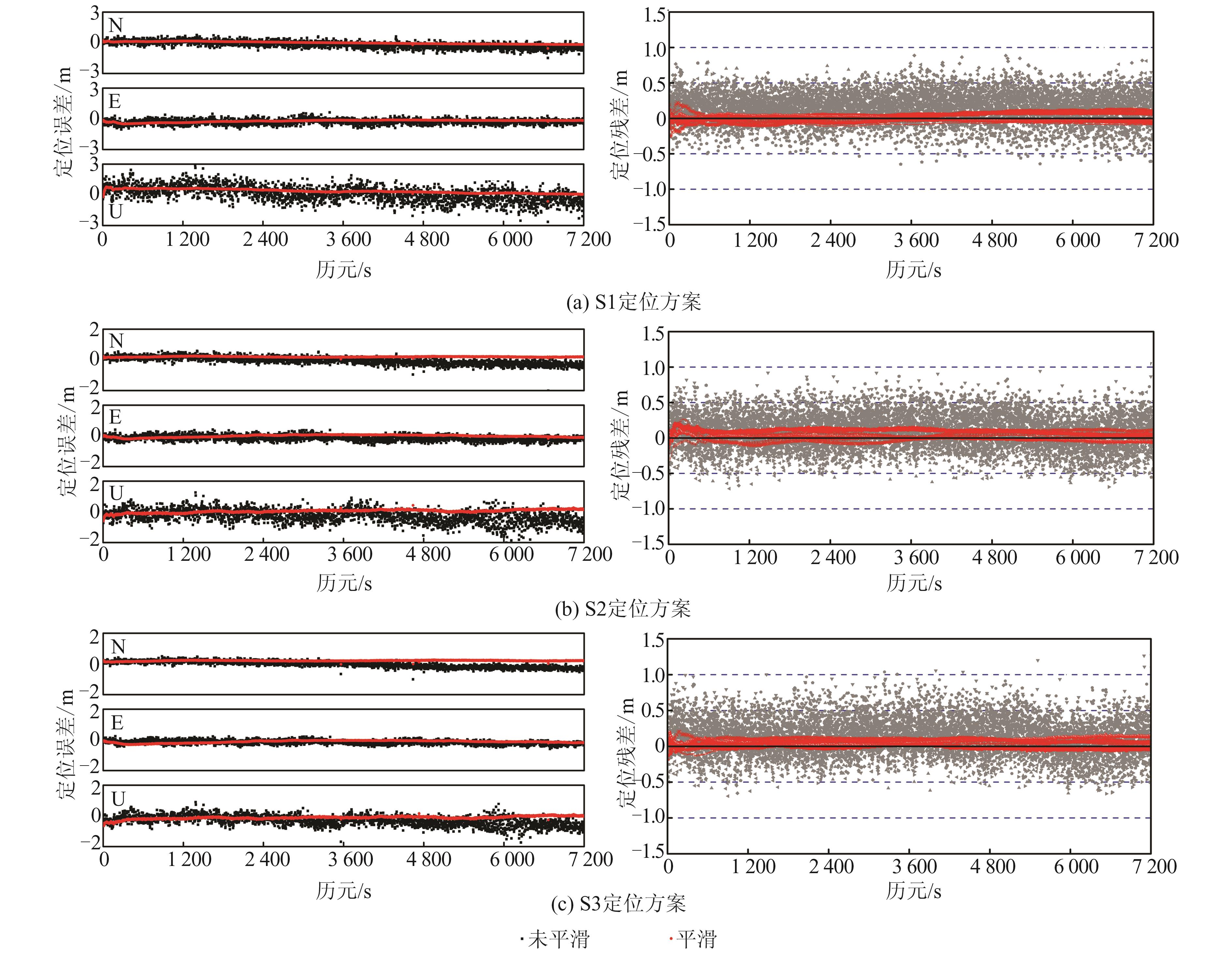BDS Pseudorange Augmentation Positioning Based on Carrier Smoothing Pseudorange
-
摘要:
伪距作为一种定位模式简单、实时性高的定位观测值,定位精度受观测值噪声的影响难以进一步提升,载波相位平滑伪距是提高伪距定位精度的主要方法。提出了一种基于载波平滑伪距的北斗卫星导航系统(BeiDou satellite navigation system,BDS)伪距增强定位方法,利用用户站周围的基准站生成误差增强信息对用户误差进行改正,同时利用载波平滑伪距公式来平滑基准站的误差增强信息,平滑后的误差增强信息不改变误差特性,兼容用户端不同频率观测值的定位,用户端可以根据需要自由选择定位模式。实验结果表明,单站误差平滑后在N、E、U方向的定位精度有大幅提高,且平滑后的残差优于未平滑的残差。用户单频、双频和多频定位平滑后在3个方向的定位精度均有提高,其中各方案下U方向定位精度有显著提高。平滑方法可以提升误差增强信息的精度,平滑后的误差增强信息兼容用户单频、双频、多频的平滑与未平滑定位,对用户观测值的平滑也可以进一步提升定位精度。
Abstract:ObjectivesPseudorange observations have the advantages of simple positioning mode and high real-time performance, but the positioning accuracy is difficult to be further improved due to the influence of the noise. Carrier phase smoothing pseudorange is the main means to improve the positioning accuracy of pseudorange.
MethodsThe method of BeiDou satellite navigation system (BDS) pseudorange augmentation positioning based on carrier smoothing pseudorange is proposed in the article, which uses the reference stations around the user station to generate error augmentation information to reduce user errors. At the same time, the smoothing pseudorange observations are used to generate error augmentation information. The smoothed error augmentation information does not change the error characteristics, and is compatible with the positioning model of different frequency observations of the users. The users can freely choose the positioning mode according to needs.
ResultsThe results show that the residuals after smoothing are better than before, and the U direction is improved by 46% when a single station is smoothed. The positioning accuracies in N,E,U three directions are improved by 16%, 31%, and 53% at three frequencies. The accuracy of the U direction is improved significantly by various schemes.
ConclusionsThe smoothed error augmentation information is compatible with the user's single-frequency, dual-frequency, and multi-frequency smoothing and unsmoothing positioning. The smoothing of the user's observation can also further improve the positioning accuracy.
-
利用地磁场方向的稳定性,通过测量传感器轴线与地磁场水平分量间的夹角实现载体航向的准确估计,是地磁定向导航及航位推算导航的基础,因此,基于磁传感器的航向估计技术得到了较为广泛的关注[1, 2]。现有的电子磁罗盘在无地磁异常干扰的情况下定向精度可达到±0.5°,但随着人类活动的加剧,建筑物、电缆及地下掩埋物等多种人工磁源逐渐增多,导致地球浅场磁异常的加剧,使得经过罗差校正的磁罗盘在磁异常干扰条件下的定向误差[3]达到数10°,严重影响了其在导航中的应用。因此,本文针对存在浅场地磁异常情况下的磁航向估计问题进行研究,设计了新的传感器阵列结构,提出了基于磁异常反演的磁航向误差实时补偿方法,以提高磁航向技术在实际应用中的鲁棒性。
1 磁传感器阵列设计及磁航向扰动探测
1.1 磁传感器阵列设计
浅场磁异常叠加在背景地磁场上,要实现精确的磁航向估计,必须对浅场磁异常进行有效分离。基于磁传感器测量得到的标量及矢量数据均为两种场的叠加,无法实现较好的分离[4],而背景地磁场在小范围内可认为是匀强磁场,即地磁梯度场较小且可忽略不计[5, 6],因此,利用传感器测量得到的磁梯度场可认为仅是浅场磁干扰源产生的异常梯度场,进而可实现背景地磁场和浅场磁异常在梯度测量上的分离。但由于磁航向估计技术是基于磁矢量信息的,必须利用浅场磁异常的梯度场反演得到其产生的磁矢量场,因此,为实现浅场磁异常梯度场的测量和矢量场的准确反演,本文设计了如图 1所示的磁传感器阵列结构。该传感器阵列由5个三轴磁通门传感器构成,相同轴上两个传感器间的基线距离为d,外围的4个传感器可构建平面十字形磁梯度张量系统用于测量多个不同方向的梯度场,进而得到磁梯度张量矩阵用于浅场磁异常源的反演。
由于地磁场及浅场异常场可看作无源的静磁场,因此,磁感应强度的散度和旋度为零,磁梯度张量的9个分量中仅有5个分量是独立的。建立如图 1所示的右手坐标系用于磁场建模,则由外围的4个传感器测量得到的磁梯度张量矩阵为:

(1) 式中,Bij表示第i个传感器在j方向上的磁场矢量值,i=1,2,3,4,j=x,y,z;Bpq表示不同方向的磁场梯度值,p,q=x,y,z。
值得注意的是,在传感器阵列构建并将其安装在载体上的过程中,传感器阵列自身的误差以及载体中铁磁材料引起的磁干扰将会严重影响磁航向的估计,在实际使用前,必须将此两种磁干扰有效消除和补偿。而本文主要针对已经完成上述两种磁干扰补偿的系统在实际应用中受到外部浅场磁异常目标干扰进而影响磁航向估计的问题进行研究,利用磁异常反演的方法补偿浅场磁异常引起的磁航向估计误差,最终实现较为准确的磁航向估计。
1.2 磁航向扰动探测
载体航向估计时,磁传感器与载体捷联在一起,故载体坐标系和传感器坐标系一致,本文建立的右手坐标系如图 2所示。假设无浅场磁异常存在时,三轴磁传感器测得的水平方向上的两个磁场分量分别为Hy和Hx,测量点处地磁场的磁偏角、磁倾角及总场值分别为D、I和F,则载体的磁航向可由式(2)估计得到:

(2) 由图 2可知,浅场磁源的存在将影响地磁场水平方向的磁矢量扰动,进而引起磁航向估计的误差,但并不是所有的浅场磁异常都会改变磁航向,且磁异常较小的情况下也可能引起较大的磁航向误差,因此,必须构建磁航向扰动探测器,准确判断磁航向变化是由于载体自身的运动扰动还是由于浅场磁异常引起的。
浅场磁异常源引起不同方向上梯度测量值的变化,原则上可根据传感器阵列测量得到的梯度值判断是否有磁异常源的存在,但由于载体在运动过程中姿态的变化对测得的梯度值具有一定的影响[7],因此,直接采用梯度值进行磁异常源是否存在的判断具有一定的非鲁棒性。磁梯度张量的张量不变量是由不同方向的梯度分量组合得到的,不受载体姿态变化的影响,因此,本文将其用于磁异常源是否存在的判断。
磁梯度张量存在多个张量不变量可用于磁异常探测,考虑磁航向估计对实时性的要求,选择I1和I2作为判断因子,其数学表达式分别为:

(3) 由式(3)可知,相比于I1,不变量I2随着距离的增大衰减更快,对于同时存在多个磁异常源的复杂情况,其优先描述浅部源的特性。
若磁传感器阵列测得的地磁场不存在浅场磁异常,则可直接利用式(2)进行磁航向的计算,若存在磁异常,需要进一步判断该异常是否引起磁航向的扰动,比如水平方向的两个磁矢量值等比例放大或缩小将不影响磁航向的计算。利用零号传感器测得的地磁场7要素中的总场F、水平分量H、竖直分量Hz和磁倾角I进行磁异常是否影响磁航向的联合判断。若磁异常对磁航向没有干扰或干扰极小,则直接利用零号传感器的测量值进行磁航向计算,若磁异常对磁航向的计算产生干扰,则利用传感器阵列测得的磁梯度张量值进行磁异常的反演,利用反演得到的传感器阵列中心点O位置处的磁矢量值补偿零号传感器测得的磁矢量值,进而在背景地磁场准确测量的情况下实现磁航向的准确估计。磁航向扰动探测流程如图 3所示。
2 磁异常反演及航向误差实时补偿
由于磁航向估计利用磁矢量信息进行载体运动方向的估计,因此,需要利用传感器阵列测量得到的浅层磁异常源的磁梯度张量数据反演其在测量中心点产生的磁矢量值,然后将零号传感器的测量值减去磁异常源产生的磁矢量值,即为背景地磁场的磁矢量值,进而可实现较为精确的磁航向估计。
在磁异常反演中,当探测距离大于2.5倍磁性物体长度时,可将磁性目标简化为磁偶极子模型,并由6个未知量描述,即磁性目标的三维位置和三维磁矩[8]。因此,要实现磁航向估计的实时误差补偿,必须实现磁异常的实时反演,即在单个测点上实时地完成磁偶极子位置及磁矩的反演。
目前,基于单点磁梯度张量数据的磁偶极子定位方法受到了较多关注,其中,Nara[9, 10]提出了联合单点测量的磁梯度张量及磁矢量数据进行磁偶极子定位的方法,但在地磁背景下无法获得磁偶极子的磁矢量信息;Roy[11]为克服背景地磁场的影响,提出了基于张量不变量的单点定位算法,但该算法需要较为复杂的磁梯度张量测量系统。Frahm[12]基于单点磁梯度张量数据的特征分析,实现了磁偶极子单位位置向量及单位磁矩向量的计算,但该方法估计得到4个不同的解且无法实现磁偶极子磁矢量信息的计算,本文在此方法基础上,联合位置、磁矩及磁梯度张量系统中包含的多点磁标量信息构建非线性方程组,在消除三个虚假解的同时,解算磁偶极子的磁矩模及测量点与磁性目标间的距离,进而实现磁矢量信息的正确反演。
假设Frahm方法得到的4个解的单位位置向量及磁矩向量为 ${{\overset{\lower0.5em\hbox{$\smash{\scriptscriptstyle\frown}$}}{r}}_{k}} {{\overset{\lower0.5em\hbox{$\smash{\scriptscriptstyle\frown}$}}{m}}_{k}},k=1,2,3,4$ 。若测量点与磁偶极子间的真实距离为R,磁偶极子的真实磁矩模为M,则磁偶极子的磁矩矢量及测点相对于磁偶极子的位置矢量分别为 ${{m}_{k}}=M\centerdot {{\overset{\lower0.5em\hbox{$\smash{\scriptscriptstyle\frown}$}}{m}}_{k}}=\left( {{m}_{kx}},{{m}_{ky}},{{m}_{kz}} \right)$ 和 $\begin{align} & {{m}_{k}}=M\centerdot {{{\overset{\lower0.5em\hbox{$\smash{\scriptscriptstyle\frown}$}}{m}}}_{k}}=\left( {{m}_{kx}},{{m}_{ky}},{{m}_{kz}} \right) \\ & {{r}_{k}}=R\centerdot {{{\overset{\lower0.5em\hbox{$\smash{\scriptscriptstyle\frown}$}}{r}}}_{k}}=\left( {{r}_{kx}},{{r}_{ky}},{{r}_{kz}} \right) \\ \end{align}$ 。
由传感器的阵列结构可知,针对不同的解,外围的4个传感器相对于磁偶极子的位置矢量可分别表示为:

(4) 则传感器与磁偶极子之间的距离可表示为Rkl=‖rkl‖,l=1,2,3,4。
设4个传感器测得的磁场总场值分别为F1ce,F2ce,F3ce和F4ce,则由磁偶极子产生的磁场总场正演公式可得以下非线性方程组:

(5) 式中,仅存在R、M和F 3个未知变量,求解方程即可得到磁偶极子的位置和磁矩矢量 rk、mk。
根据磁偶极子的磁梯度张量正演公式,计算4个不同的磁偶极子在测量点产生的磁梯度张量值,并将其与真实值相比较即可实现虚假解的去除和磁性目标的单点磁梯度张量定位及磁矩反演,进而完成磁异常的三分量磁矢量反演计算。
假设反演得到磁偶极子的磁矩为m0,相对于测量中心点的位置为r0,则其在测量中心点O处产生的三分量磁矢量值为:

(6) 补偿得到的背景地磁场的三分量值为:

(7) 式中,B0为零号传感器测得的三分量磁矢量值。
则在存在影响磁航向估计的磁异常场的情况下,真实磁航向可利用式(7)中反演得到的背景地磁场的三分量值进行计算。
3 实验与分析
为验证本文提出的磁航向误差补偿方法的可行性,采用5个三轴磁通门传感器构建传感器阵列,在地面上放置永磁体模拟浅场磁异常进行磁航向实验,如图 4所示。为详细分析磁航向估计中磁异常反演的正确性,实验采用单点测量的方式进行,实验人员手持传感器阵列且距离地面约50 cm,在测量曲线上每隔10 cm进行一次数据采集。
在永磁体左右两侧各选取一条测线进行磁航向的计算,测量得到的张量不变量及补偿前后的方位角如图 5、图 6所示。
由图 5、 图 6可知,磁梯度张量的张量不变量I1和I2可实现磁异常源是否存在的准确判断。实验所用永磁体的磁矢量场与地磁矢量场间存在较大的方向偏差,因此,在传感器阵列距离永磁体较近时,产生了10~20°左右的磁航向估计误差。在利用磁传感器阵列测得的磁梯度张量数据进行磁异常源产生的磁矢量场反演的基础上,进行了磁航向计算的补偿,从补偿结果可以看出,论文所提算法可实现浅场磁异常源引起的磁航向误差的补偿。补偿后得到的磁航向方位角仍存在一定的波动,这是由于实验人员手持传感器阵列无法一直保持水平姿态及方向不变而导致的。
4 结 语
本文针对由地磁矢量信息进行磁航向估计时易受浅场磁异常源干扰的问题,设计了传感器阵列结构,通过测量磁异常源产生的磁梯度场进而反演其产生的磁异常矢量场,在此基础上计算得到较为准确的背景地磁矢量场,实现磁航向误差的实时补偿。实验结果表明,利用磁梯度张量的单点反演方法可有效消除磁异常目标引起的磁航向误差,具有较高的补偿精度。
http://ch.whu.edu.cn/cn/article/doi/10.13203/j.whugis20220150 -
表 1 用户站误差增强信息定位方案
Table 1 Positioning Schemes of Error Augmentation Information in User Station
定位方案 定位模式 增强信息 用户站 E1 单点定位 无 未平滑 E2 单基准站增强定位 平滑/未平滑 E3 多基准站增强定位 平滑/未平滑 表 2 不同用户站增强定位方案精度统计/m
Table 2 Positioning Accuracy Statistics of Different Positioning Schemes in User Station/m
定位方案 用户增强信息 RMS 残差中误差 N方向 E方向 U方向 E1 无 0.621 0.389 1.199 2.135 E2 未平滑 0.525 0.354 0.766 0.431 平滑 0.336 0.259 0.415 0.374 E3 未平滑 0.335 0.244 0.546 0.346 平滑 0.201 0.206 0.332 0.269 表 3 用户站增强定位方案
Table 3 Positioning Scheme of Error Augmentation Information in User Station
定位方案 定位模式 增强信息 用户站 S1 增强定位 平滑 单频数据平滑/未平滑 S2 双频数据平滑/未平滑 S3 三频数据平滑/未平滑 表 4 不同定位方案定位精度统计/m
Table 4 Positioning Accuracy Statistics of Different Positioning Schemes/m
定位方案 用户站是否平滑 RMS 残差中误差 N方向 E方向 U方向 S1 未平滑 0.372 0.385 0.746 0.295 平滑 0.209 0.243 0.396 0.079 S2 未平滑 0.240 0.225 0.519 0.280 平滑 0.195 0.176 0.207 0.075 S3 未平滑 0.201 0.206 0.332 0.269 平滑 0.168 0.141 0.155 0.066 表 5 不同平滑方法的定位精度统计/m
Table 5 Positioning Accuracy Statistics of Different Smoothing Methods/m
频率 平滑方法 RMS 残差中误差 N方向 E方向 U方向 双频 本文方法 0.195 0.176 0.207 0.075 Hatch滤波 0.225 0.182 0.299 0.125 三频 本文方法 0.168 0.141 0.155 0.066 Hatch滤波 0.207 0.177 0.241 0.073 -
[1] 程惠红, 宋小刚. 2023年大地测量学领域自然科学基金项目申请与资助分析[J]. 武汉大学学报(信息科学版), 2024, 49(3): 426-433. Cheng Huihong, Song Xiaogang. Analysis of the National Natural Science Foundation Projects of Geodesy Field in 2023[J]. Geomatics and Information Science of Wuhan University, 2024, 49(3): 426-433.
[2] Hatch R. The Synergism of GPS Code and Carrier Measurements[C]//International Geodetic Symposium on Satellite Doppler Positioning, New Mexico,USA, 1982.
[3] 孙正明, 高井祥, 王坚. GPS双频相位平滑伪距权重因子的探讨[J]. 海洋测绘, 2007, 27(4): 13-16. Sun Zhengming, Gao Jingxiang, Wang Jian. Discussion on Weighting Factors of GPS Dual Frequency Phase-Smoothed Pseudo-Range[J]. Hydrographic Surveying and Charting, 2007, 27(4): 13-16.
[4] 张宇, 赵齐乐, 蒋科材, 等. 基于BDS-3的陆地探测一号星间基线高精度解算方法[J]. 武汉大学学报(信息科学版), 2024, 49(10): 1763-1769. Zhang Yu, Zhao Qile, Jiang Kecai, et al. High-Precision Inter-Satellite Baseline Determination Method for Lutan-1 Based on BDS-3[J]. Geomatics and Information Science of Wuhan University, 2024, 49(10): 1763-1769.
[5] 郭建锋, 欧吉坤, 袁运斌, 等.双频GPS数据的最优相位平滑伪距算法研究[J] .自然科学进展, 2008, 18(2):221-224. Guo Jianfeng, Jikun Ou, Yuan Yunbin, et al. Research on Optimal Algorithm of Phase-Smoothed Pseudorange for Dual-Frequency GPS Data[J]. Advances in Natural Science, 2008, 18(2):221-224.
[6] 杨春燕, 吴德伟, 卢艳娥, 等. 基于补充卡尔曼滤波的载波相位平滑伪距算法[J]. 空军工程大学学报(自然科学版), 2008, 9(5): 52-56. Yang Chunyan, Wu Dewei, Lu Yan'e, et al. A Phase-Smoothed Pseudo-Range Algorithm Based on Complementary Kalman Filtering[J]. Journal of Air Force Engineering University (Natural Science Edition), 2008, 9(5): 52-56.
[7] 刘明亮, 安家春, 王泽民, 等. BDS-3多频伪距定位性能分析[J]. 武汉大学学报(信息科学版), 2023, 48(6): 902-910. Liu Mingliang, An Jiachun, Wang Zemin, et al. Performance Analysis of BDS-3 Multi-Frequency Pseudorange Positioning[J]. Geomatics and Information Science of Wuhan University, 2023, 48(6): 902-910.
[8] 刘广军, 郭晶, 罗海英. GNSS最优载波相位平滑伪距研究[J]. 飞行器测控学报, 2015, 34(2): 161-167. Liu Guangjun, Guo Jing, Luo Haiying. Optimal Smoothing of GNSS Pseudo-Range by Carrier Phase[J]. Journal of Spacecraft TT&C Technology, 2015, 34(2): 161-167.
[9] 徐博, 刘文祥, 廖鸣. 一种基于电离层变化率的单频载波相位平滑伪距改进方法[J]. 中南大学学报(自然科学版), 2014, 45(2): 464-467. Xu Bo, Liu Wenxiang, Liao Ming. An Improved Method of Single Frequency Carrier Phase Smoothing Pseudo[J]. Journal of Central South University (Science and Technology), 2014, 45(2): 464-467.
[10] 陈正生, 张清华, 崔阳, 等. 单频载波相位移动开窗平滑伪距算法及精度分析[J]. 武汉大学学报(信息科学版), 2020, 45(7): 964-973. Chen Zhengsheng, Zhang Qinghua, Cui Yang, et al. Single Frequency Carrier Smoothing Pseudo-range Algorithm and Accuracy Analysis Based on Moving Window[J]. Geomatics and Information Science of Wuhan University, 2020, 45(7): 964-973.
[11] 陈正生, 张清华, 李林阳, 等. 电离层延迟变化自模型化的载波相位平滑伪距算法[J]. 测绘学报, 2019, 48(9): 1107-1118. Chen Zhengsheng, Zhang Qinghua, Li Linyang, et al. An Improved Carrier Phase Smoothing Pseudo-range Algorithm with Self-Modeling of Ionospheric Delay Variation[J]. Acta Geodaetica et Cartographica Sinica, 2019, 48(9): 1107-1118.
[12] 骆飞, 常国宾, 陈超. 顾及有色噪声影响的位置域双频载波相位平滑伪距算法[J]. 测绘通报, 2019(3): 6-10. Luo Fei, Chang Guobin, Chen Chao. Position Domain Dual-Frequency Carrier Smoothed Code Filter with Colored Noise[J]. Bulletin of Surveying and Mapping, 2019(3): 6-10.
[13] 唐卫明, 刘智敏. GPS载波相位平滑伪距精度分析与应用探讨[J]. 测绘信息与工程, 2005, 30(3): 37-39. Tang Weiming, Liu Zhimin. Precision Evaluating and Applications of GPS Code Pseudorange Smoothing Algorithm Based on Carrier Observables[J]. Wtusm Bulletin of Science and Technology, 2005, 30(3): 37-39.
[14] 郑南山, 李增科. 多普勒平滑伪距在GPS/INS紧耦合导航中的应用[J]. 武汉大学学报(信息科学版), 2014, 39(10): 1158-1162. Zheng Nanshan, Li Zengke. Application of Doppler Smoothing Pseudo-Range in GPS/INS Tightly-Coupled Navigation[J]. Geomatics and Information Science of Wuhan University, 2014, 39(10): 1158-1162.
[15] 孟凡军, 李树军, 杜祯强. BDS三频双差载波相位组合平滑伪距算法[J]. 测绘科学技术学报, 2019, 36(5): 452-457. Meng Fanjun, Li Shujun, Du Zhenqiang. Pseudo-range Smoothing Algorithm Using BDS Triple-Frequency Double-Difference Carrier Phase Combination[J]. Journal of Geomatics Science and Technology, 2019, 36(5): 452-457.
[16] 常志巧, 郝金明, 李军正. 载波相位平滑伪距及其在差分定位中的应用[J]. 海洋测绘, 2009, 29(3): 21-23. Chang Zhiqiao, Hao Jinming, Li Junzheng. Carrier Phase Smoothed Pseudorange and Its Application in DGPS[J]. Hydrographic Surveying and Charting, 2009, 29(3): 21-23.
[17] 高星伟,葛茂荣.GPS/GLONASS伪距差分的数据处理[J].测绘通报,2000(6):1-3. Gao Xingwei, Ge Maorong.Data Processing of GPS/GLONASS Pseudorange Difference[J]. Bulletin of Surveying and Mapping,2000(6):1-3.
[18] 冯宝红, 叶松. GPS伪距差分解算改进模型的研究[J]. 南京工业大学学报(自然科学版), 2005, 27(4): 64-66. Feng Baohong, Ye Song. Research on Improved Model with GPS Pseudorange Differential Analysis[J]. Journal of Nanjing University of Technology, 2005, 27(4): 64-66.
[19] 邓健, 王庆, 潘树国, 等. 基于多参考站的分米级GPS伪距差分定位方法[J]. 东南大学学报(自然科学版), 2010, 40(2): 316-319. Deng Jian, Wang Qing, Pan Shuguo, et al. Method of Decimeter-Level Pseudo-Range Differential Positioning for GPS Based on Multiple Reference Stations[J]. Journal of Southeast University (Natural Science Edition), 2010, 40(2): 316-319.
[20] 李鹤峰, 秘金钟, 党亚民, 等. 基于CORS的多基准站BDS/GPS融合差分网定位性能分析[J]. 大地测量与地球动力学, 2014, 34(6): 81-85. Li Hefeng, Bei Jinzhong, Dang Yamin, et al. Study on Positioning with Differential Network of BDS/GPS Fusion System Based on Multiple CORS Reference Stations[J]. Journal of Geodesy and Geodynamics, 2014, 34(6): 81-85.
[21] 祝会忠, 李博, 徐爱功, 等. 长距离单历元单频非差北斗网络差分方法[J]. 测绘科学, 2016, 41(5): 14-20. Zhu Huizhong, Li Bo, Xu Aigong, et al. Method of Un-differential BDS Network Difference of Long Range at Single Epoch of Single Frequency[J]. Science of Surveying and Mapping, 2016, 41(5): 14-20.
[22] 张成军, 杨力, 陈军. 提高GPS载波相位平滑伪距定位精度的算法研究[J]. 大地测量与地球动力学, 2009, 29(4): 106-110. Zhang Chengjun, Yang Li, Chen Jun. Improving Point Positioning Accuracy Using GPS Carrier Smoothed Pseudorange[J]. Journal of Geodesy and Geodynamics, 2009, 29(4): 106-110.
-
期刊类型引用(12)
1. 孟萌萌,冯贝贝. AM-1DCNN算法在土地覆盖分类中的应用. 福建电脑. 2025(03): 36-39 .  百度学术
百度学术
2. 罗蓉蓉,董燕. 基于GEE云平台和Sentinel数据的滇池湿地制图. 安徽农业科学. 2025(04): 205-208+242 .  百度学术
百度学术
3. 李坤玉,王雪梅,李锐,李顿. 融入辅助数据集的面向对象土地利用分类研究. 中山大学学报(自然科学版)(中英文). 2024(01): 34-44 .  百度学术
百度学术
4. 孟萌萌,黄瑞瑞,毋琳,黄亚博. 基于Mult-TWDTW算法的时序SAR图像土地覆盖分类. 计算机系统应用. 2024(05): 203-209 .  百度学术
百度学术
5. 段宗亮,周晓. 基于遥感技术的镇沅县茶树资源研究. 西部林业科学. 2024(05): 140-145 .  百度学术
百度学术
6. 潘竞,赵浩楠,田聪,阿斯娅·曼力克,贠静,艾尼玩·艾买尔,孙宗玖,郑逢令. 基于Sentinel数据和机器学习算法的苜蓿遥感识别研究. 草食家畜. 2024(06): 35-45 .  百度学术
百度学术
7. 李子康,殷晓洁,刘一飞,唐继敏,王妍. 滇东南典型喀斯特山区石漠化时空演变及生态敏感性评价. 生态环境学报. 2024(11): 1792-1802 .  百度学术
百度学术
8. 张智洋,赵颖慧,甄贞. 基于LUCC的1986–2022年松花江流域陆地生态系统碳储量动态监测. 植物生态学报. 2024(10): 1274-1290 .  百度学术
百度学术
9. 闫明,庞勇,何云玲,蒙诗栎,魏巍. 基于GEE云平台和Sentinel-2数据的普洱市森林覆盖制图. 遥感技术与应用. 2023(02): 432-442 .  百度学术
百度学术
10. 刘文宋,张仲英,郑琳,王法景,张舒祺,郭风成. 顾及PolSAR影像极化-空间信息的农作物识别方法. 测绘科学. 2023(05): 152-161 .  百度学术
百度学术
11. 陈爱琳,江洪,麻霞. 2000—2020年厦门港用地变化遥感监测与空间格局分析. 海南大学学报(自然科学版). 2022(02): 182-192 .  百度学术
百度学术
12. 杨志刚,郭盛才,徐期瑚,练丽,苏雅丽. 南岭国家公园森林资源现状分析. 林业与环境科学. 2022(S1): 39-41+46 .  百度学术
百度学术
其他类型引用(11)






 下载:
下载:





